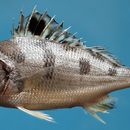Diagnostic Description
provided by Fishbase
Small-sized fish of moderately deep body. Isthmus narrow, forming a groove. Chin with 2 pairs or small pores. This species is characterized by several dark large elongate blotches on the upper back, one forming a saddle on the nape.
Life Cycle
provided by Fishbase
Oviparous, distinct pairing during breeding (Ref. 205).
Migration
provided by Fishbase
Amphidromous. Refers to fishes that regularly migrate between freshwater and the sea (in both directions), but not for the purpose of breeding, as in anadromous and catadromous species. Sub-division of diadromous. Migrations should be cyclical and predictable and cover more than 100 km.Characteristic elements in amphidromy are: reproduction in fresh water, passage to sea by newly hatched larvae, a period of feeding and growing at sea usually a few months long, return to fresh water of well-grown juveniles, a further period of feeding and growing in fresh water, followed by reproduction there (Ref. 82692).
Morphology
provided by Fishbase
Dorsal spines (total): 12; Dorsal soft rays (total): 13 - 14; Analspines: 3; Analsoft rays: 7
Trophic Strategy
provided by Fishbase
Occurs in inshore waters of the continental shelf (Ref. 75154). Often found in sandy or muddy areas. Feeds on crustaceans and fishes (Ref. 9137).
- Recorder
- Drina Sta. Iglesia
Biology
provided by Fishbase
Found in coastal waters over sand near reefs. Feeds on crustaceans and fishes (Ref. 5213). Edible but spoils easily.
Importance
provided by Fishbase
fisheries: commercial
分布
provided by The Fish Database of Taiwan
分布於印度-西太平洋區,西起紅海,東至菲律賓,北至台灣、日本,南至澳洲。台灣分布於西部及澎湖海域。
利用
provided by The Fish Database of Taiwan
一般利用流刺網、拖網或延繩釣漁法捕獲。肉味鮮美,適合油煎或煮薑絲湯。
描述
provided by The Fish Database of Taiwan
體側扁,呈長橢圓型,背緣弧形隆起,腹緣略呈弧形。頭中大。吻鈍尖。口中大,端位;上頜稍長於下頜,上下頜齒細小,絨毛狀,外列齒大;鋤骨、腭骨及舌面皆無齒。頦部具一長而深的中央溝;頦孔1對。體被薄櫛鱗,背鰭及臀鰭基部均具鱗鞘;側線完整,側線鱗數50-55。背鰭單一,硬棘部及軟條部間無明顯缺刻,硬棘數XII,第IV棘最長,軟條數13-15;臀鰭小,與背鰭鰭條部同形,硬棘數III,第II棘強大,軟條數7;胸鰭中長,長於腹鰭;尾鰭內凹形。體呈銀白色,背部呈銀灰色,胸鰭以上有4條黑色斜帶,背鰭硬棘部具黑色斑駁,背、尾鰭具黑緣,各鰭則黃色。
棲地
provided by The Fish Database of Taiwan
主要棲息於沿岸靠近礁石的砂泥底質海域,以小魚、蝦、甲殼類或砂泥地中的軟體動物為主食。
Pomadasys maculatus
provided by wikipedia EN
Pomadasys maculatus, commonly known as the saddle grunt, blotched grunt or blotched javelin, is a species of marine ray-finned fish, a grunt belonging to the family Haemulidae. It is native to the Indo-West Pacific region.
Description
Pomadasys maculatus has a body which is around two and half times as long as it is deep. It has a blunt head with a convex upper profile and a small mouth which has brush like bands of teeth on its jaws. The dorsal fin has 12 spines and 13-15 soft rays while the anal fin has 3 spines and 6-8, normally 7, soft rays. It has an overall silvery grey colour with a purplish or brownish head, there are a series of broken vertical bars across the nape and back, the bar on the nape being the most obvious. The spined part of the dorsal fin has a large black blotch, the dorsal and caudal fins have black margins while the remaining fins are yellowish.[3] This species attains a maximum total length of 59.3 cm (23.3 in), although 30 cm (12 in) is more typical, with a maximum published weight of 3.2 kg (7.1 lb).[2]
Distribution
Pomadasys maculatus has a wide Indo-Pacific distribution. It is found along the east African coast from the Red Sea south to the Eastern Cape Province in South Africa, across the Indian Ocean, including the Seychelles and the Mascarenes. Its range extends as far east as Queensland and Papua New Guinea and north to southern Japan.[1]
Habitat and biology
Pomadasys maculatus can be found at depths between 20 and 120 m (66 and 394 ft) in coastal inshore waters. It is an amphidromous species[1] found in open bays and estuaries.[3] It feeds on crustaceans or fishes. It is an oviparous species which forms distinct pairs for spawning.[2]
Systematics
Pomadfasys maculatus was first formally described in 1793 as Anthias maculatus by the German naturalist Marcus Elieser Bloch (1723–1799) with the type locality given as the East Indies.[4] The specific name maculatus means "spotted", referring to the blotches across the back and nape.[5]
Utilisation
Pomadasys maculatus is commercially fished for throughout its range.[1] It is caught using bottom trawls, handlines, set nets, traps, and spears. It is often quite abundant in areas used to trawl for prawns. The catch is sold fresh, with a quantities being preserved by either salting or smoking.[3]
References
-
^ a b c d Collen, B.; Richman, N.; Beresford, A.; Chenery, A. & Ram, M. (Sampled Red List Index Coordinating Team) (2017) [errata version of 2010 assessment]. "Pomadasys maculatus". IUCN Red List of Threatened Species. 2010: e.T155330A115301796. doi:10.2305/IUCN.UK.2010-4.RLTS.T155330A4776701.en. Retrieved 6 April 2021.
-
^ a b c Froese, Rainer; Pauly, Daniel (eds.) (2019). "Pomadasys maculatus" in FishBase. December 2019 version.
-
^ a b c R.J. MacKay (2001). "Haemulidae". In Carpenter, K.E. & Volker H. Neim (eds.). The Living Marine Resources of the Western Central Pacific Volume 5: Bony fishes part 3 (Menidae to Pomacentridae) (PDF). FAO Species Identification Guide for Fishery Purposes. FAO Rome. p. 2988.
-
^ Eschmeyer, William N.; Fricke, Ron & van der Laan, Richard (eds.). "Species in the genus Pomadasys". Catalog of Fishes. California Academy of Sciences. Retrieved 6 April 2021.
-
^ Christopher Scharpf; Kenneth J. Lazara, eds. (5 January 2021). "Order LUTJANIFORMES: Families HAEMULIDAE and LUTJANIDAE". The ETYFish Project Fish Name Etymology Database. Christopher Scharpf and Kenneth J. Lazara. Retrieved 6 April 2021.

- license
- cc-by-sa-3.0
- copyright
- Wikipedia authors and editors
Pomadasys maculatus: Brief Summary
provided by wikipedia EN
Pomadasys maculatus, commonly known as the saddle grunt, blotched grunt or blotched javelin, is a species of marine ray-finned fish, a grunt belonging to the family Haemulidae. It is native to the Indo-West Pacific region.
- license
- cc-by-sa-3.0
- copyright
- Wikipedia authors and editors
Description
provided by World Register of Marine Species
Found in coastal waters over sand near reefs. Feeds on crustaceans and fish (Ref. 5213).
Froese, R. & D. Pauly (Editors). (2023). FishBase. World Wide Web electronic publication. version (02/2023).
- license
- cc-by-4.0
- copyright
- WoRMS Editorial Board

